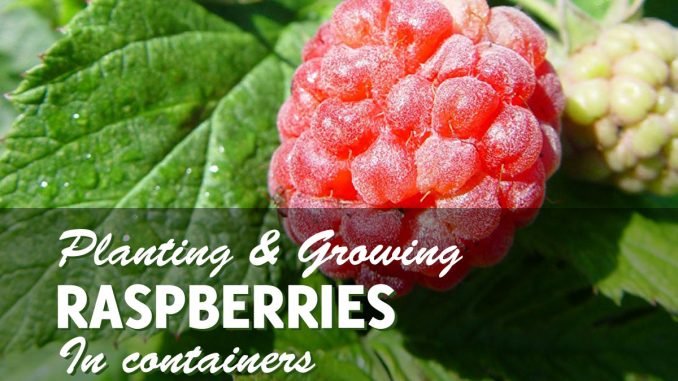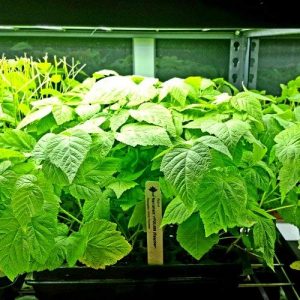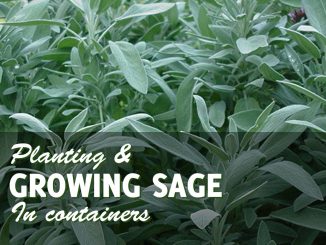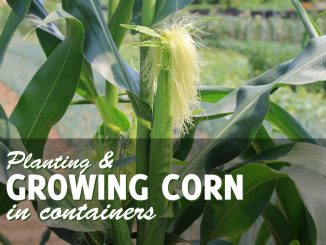
Do not let a small garden deter you from growing your own raspberries. Growing raspberries in containers is very easy. Raspberries are loved for their sharp, tart flavors that make them perfect for a romantic dessert.
Traditionally served during Valentine’s Day as a dessert (as well as an aphrodisiac), they have gained popularity in the modern diet because of their richness in nutrients, which provide numerous health benefits. From a rare, novelty fruit, it is now grown in large quantities to satisfy the demands of the healthy public.
Raspberry crowns and roots are perennial, but the canes can live for two years. Canes (or suckers) are produced by the plant each spring from buds. First-year canes have stems that are green in color. Second-year canes have stems that are thin and covered with a bark that is brown in color.
Before You Start Growing Raspberries in Containers
When you start growing raspberries in pots, choose a spot that has the most number of hours of sun in your garden. For container cultivation, it is recommended that you plant varieties that are disease-resistant and are not necessarily vigorous in growth. You can choose “Rubus Shortcake” as this doesn’t produce as wild foliage compared to other varieties. Your raspberries will need to have a post built with a wire trellis for support. Give your plants additional support by having a piece of string tied across the row.
Picking the Right Container to Grow Raspberries

Your pots for your raspberries must be at least 12 inches of diameter. A 5-gallon bucket or container can also be used for a single plant for growing raspberries. Since they need as much water that they can get, a plastic container is advised as it does not leech out moisture from your plant. Drill drainage holes at the bottom of the pot to make sure that excess water finds its way out of the container. A waterlogged raspberry does not grow too well and is prone to many diseases.
Preparing Potting Mix for Raspberries in Pots
Do not use ordinary garden soil when growing raspberries in pots. Soil from your garden has many weed seeds as well as pathogens (fungus, viruses, bacteria) that produce disease and harm your raspberries. Instead, use a soil potting mix from your local nursery or gardening store. They are made up of sterile or pasteurized soil, peat moss, perlite, or vermiculite. The mix is light enough to drain excess water out but absorbent enough to keep just the right amount of water and nutrients for your crops.
Test your potting mix to know the pH and nutrient levels. A pH of 5.6-6.2 is best for growing raspberries. Adjust the pH by giving it lime to increase or sulfur to decrease the pH level. Add in a 10-10-10 fertilizer according to package instructions to put in nutrients to your soil. Still, for a healthier plant that is low in chemical levels, go organic by giving your potting mix a good amount of composted manure or liquid organic fertilizer. This is done several days before planting to help loosen the soil and have the nutrients seep through your potting mix better.
Growing Raspberries in Containers From Seeds
Starting raspberries from seeds can take a lot of work. Choose seeds from raspberries that you like the flavor of. You can get the seeds by putting the berries in water and pulsed through a food processor. Remove the pulp and the water and dry the seeds well. Stratify your seeds by putting them inside a tightly sealed container and into the freezer a couple of months. Prepare your seeds by letting them stay in your refrigerator covered with a paper towel and protected inside a Ziploc bag afterward for 30 days.
Place the seeds indoors on a dampened potting mix and cover with ¼ inch of compost. Water well using a fine hose and cover with clear plastic to promote germination. After a couple of weeks, when your seeds have sprouted, be sure to water the soil and not the leaves as to prevent mold. Harden off the seeds for two weeks before transplanting them outdoors.
Starting With Raspberry Transplants

Starter raspberry plants are ideal and easier for growing raspberries in containers. Choose a variety that grows well in conainters, such as the Joan J Thornless Ever Bearing. Plant them by creating a hole that is 5-6 inches deep and place your plantings or transplants into the crater. Cover with soil and water well.
Care of Container Grown Raspberries
Watering & Weeding
Always make sure that you keep the soil moist but not wet while your raspberries grow. It is necessary that your raspberries receive an inch or two of water per week. Keep weeds at bay by shallow-tilling the soil and pulling out any weeds that manage to grow. You can also keep weeks at bay by mulching the soil. Mulching also helps insulate the soil and retain moisture. You can use wood chips (make sure they are not chemically treated), bark, rotted leaf mulch, or pine needles to cover your topsoil to about 4 inches in height.
Fertilizing Your Raspberries
Do not give your plants too much fertilizer in the first few months of growing raspberries in pots. Once they reach a full year, you can give them regular amounts of fertilizer, such as 10-10-10. Apply according to package instructions and slightly increase the amount if you are using a heavy layer of mulch. It would be better if you use compost as a mulch to keep your plants insulated and healthy. You can side-dress your crops with compost manure once a month or feed them with compost tea every two weeks.
Pests and Diseases When Growing Raspberries in Containers
There are several diseases and pests that you have to watch out for while you grow your raspberries. Cane borers are larvae produced by an adult Japanese beetle. Tarnished plant bug is also a member of the beetle family that feasts on raspberries that are still young. Keep them at bay by handpicking them out or spraying your crops with an appropriate pesticide. Spraying your crops daily with compost tea may help prevent the problem.
Raspberry mosaic and verticillium wilt are also common diseases that can harm your crops. They are soil-borne and can come from infected eggplants, potatoes, tomatoes, or peppers. Keep your plants away from these crops as much as possible, and practice cycling to prevent these problems.
Harvesting Your Raspberries Grown in Containers
When growing raspberries in containers, you can harvest the raspberries by mid-summer to early frost. Harvest your raspberries when they are plump, with deep, rich, and vibrant color. The deeper the color, the better they taste. Harvest them by carefully placing your thumb and forefinger at the top of the fruit where it meets the slender stem that’s holding it to the plant. Pull out the fruit carefully and gingerly, being careful not to squash the fruit before it dislodges from the plant. Harvest every two weeks, or birds will beat you to succulent fruits.
Storing Fresh Raspberries
Harvested raspberries must be consumed immediately or within 24 hours since they do not store well in a fridge or container. You can, however, freeze raspberries to keep them longer to make them a perfect addition to frozen desserts, smoothies, and ice cream.




Be the first to comment